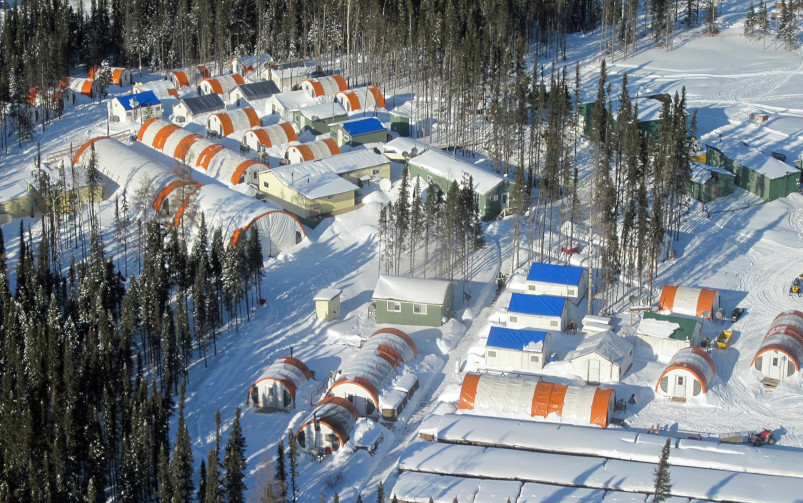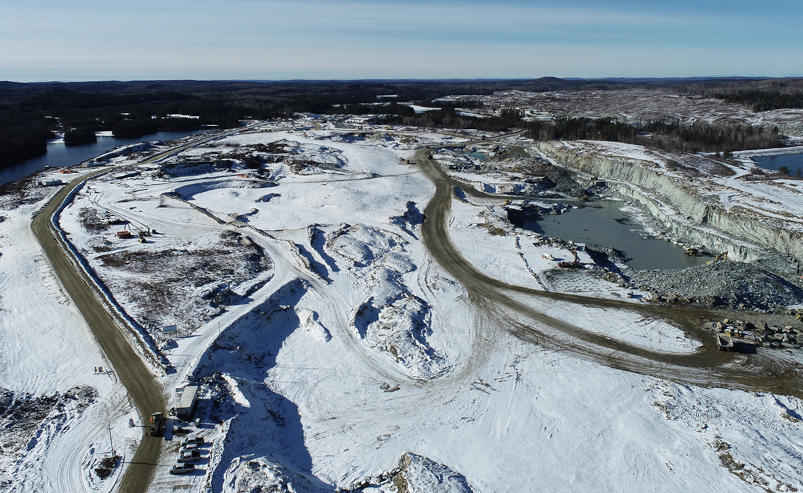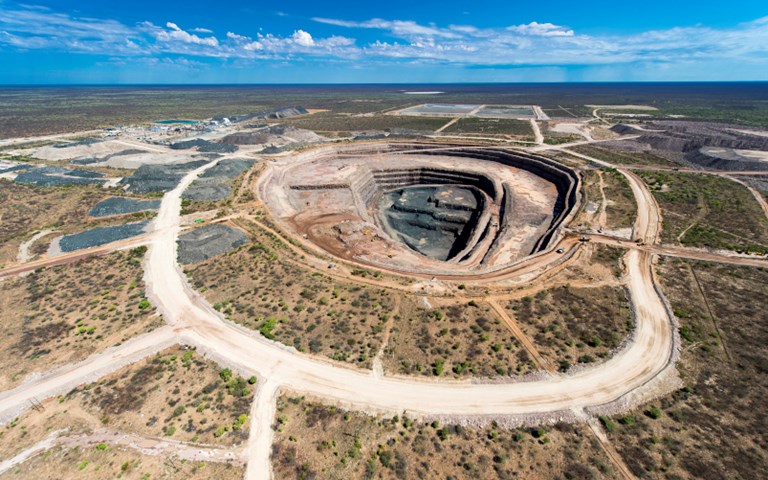Lucara's proposed underground expansion for its Karowe mine in Botswana could increase its life-of-mine by 20 years. Courtesy of Lucara Diamond.
Welcome back to your weekly mining news recap, where we catch you up on some of the news you may have missed. This week’s headlines include Lucara securing funding for an underground expansion at Karowe, a crucial decision by the Ontario Court of Appeals that could expand liabilities for employers, and the latest in ore conveyors.
This week was CIM’s virtual Convention + Expo, CIMVTL21. We had a metric tonne of amazing speakers on topics of interest to anyone in the mining community, but here are a few highlights:
New CIM president Pierre Julien stressed in a Q&A with CIM Magazine his goal of highlighting the high-tech and changing nature of the mining industry. On Monday, Jody Kuzenko, president and CEO of Torex Gold Resources; David Cataford, president and CEO of Champion Iron; Denise Johnson, group president at Caterpillar; and Mark Cutifani, chief executive at Anglo American held a lively discussion on resilience and adaptation in the face of the pandemic, and how their companies have worked to come out of it stronger than ever.
On Tuesday, attendees heard from Eric Desaulniers, founder, president and CEO of Nouveau Monde Graphite as he spoke on minimizing risk in graphite mining.
Wednesday’s keynote was a presentation by Jerry Asp, co-founder of the Tahltan Nation Development corporation, on how the mining industry can better work to empower Indigenous communities and help them thrive.
Finally, Thursday's concluding keynote from Osisko Metals president and COO Jeff Hussey provided an urgent reminder that resiliency and innovation will be required to capitalize on the coming commodities super-cycle. The last day also featured the Canadian Mining Education Forum, in which moderator Patrick Merrin, formerly COO of Mining Washington Companies, guided panelists Mapi Mobwano, president and CEO of Arcelor Mittal Mining Canada, and Gordon Stothart, president and CEO of Iamgold, in a discussion on what students can do to meet the industry’s expectations of today’s mining engineers.
New digital tools and sensor technologies, along with environmental and cost advantages, help make continuous mining systems a strong option for mining companies. Though they mean more constraints than discontinuous mining systems in that they are less flexible than “truck and shovel” systems, continuous systems have many upsides, from operations costs to lower greenhouse gas emissions.
Over a half-century ago, the world witnessed the Aberfan mining disaster in South Wales, which took the lives of 144 people – including 116 children – in 1966, after a spoil tip slid down, causing a landslide that buried a school located a mile beneath it.
CIM has received $1.74 million from industry partners under the Corporate Patron Initiative. Thirty-six companies contributed to help CIM achieve its goal of $2 million in order to help the institute continue to carry out its work promoting healthy, safe and sustainable practices; fostering diversity and inclusion; improving mineral literacy; preparing the next generation of leaders; and celebrating the achievements of the industry and its members.
The Ontario Court of Appeals issued a crucial decision in Ontario (Labour) v. Sudbury (City) that may expand liabilities for companies, as reported by Occupational Health and Safety Canada. The decision “[s]uggests that an employer may have broad OHSA responsibilities solely on the basis that it had a worker on the project — perhaps despite engaging a constructor.” The decision could significantly expand liabilities under the Ontario Occupational Health and Safety Act (OHSA) for employers, and could have further implications for inspectors and prosecutors.
Baffinland reported that it has temporarily suspended operations at its Mary River project in Nunavut due to a COVID-19 outbreak. The first incident of transmission was confirmed on May 2nd, and Baffinland said that its “robust screening process has identified an increase in presumptive positive cases at the Mary River Project.” Essential workers will continue to maintain the site and continue environmental monitoring, and Baffinland says its working on supplying COVID-19 vaccines to workers on site.
Alberta has changed the way oilsands companies can calculate environmental liability payments, as reported by the Financial Post. Because of last year’s low oil prices, security payments will now be based on the revenue earned from each barrel of oil they produced, as opposed to on the price of oil. The one-time change to the province’s Mine Financial Security Program for oilsands companies was put in place on Thursday.
Lucara Diamond has secured up to $220 million in senior debt facilities, which it says will be put towards a $514 million underground expansion of its Karowe mine in Botswana, as reported by Mining.com. The expansion project is expected to take five years to complete, but Lucara says it would increase Karowe’s mine life by 20 years and would generate over US$5.25 billion in revenue.
The government of Saskatchewan is supporting Saskatchewan Mining and Minerals Inc.’s (SMMI) upgrade to its sodium sulfate plant in Chaplin, as reported by World Fertilizer Magazine. The upgrade will have an estimated cost of $220 million, and according to SMMI, will allow for annual production of 150,000 metric tonnes of sulfate of potash, and will result in a 50 per cent increase in jobs at the facility. The provincial government has also conditionally approved the project for the “Sodium Sulphate Incentive”, which provides a 10-per cent credit for capital projects that diversify products or improve operating efficiency.
Pandora, the world’s biggest jeweller, announced that it will no longer use mined diamonds in its products, and will instead exclusively use lab-created diamonds, as reported by iPolitics. Pandora cited concerns over the diamond industry’s environmental and human rights practices, and said that the lab-grown diamonds have identical chemical characteristics to the mined ones. Those who have received the May issue of CIM Magazine can get informed on the science of lab-created diamonds and how they are changing the diamond industry by reading “Diamond versus diamond” by Carolyn Gruske.
Companies continue to release their first quarter results, and we’ve rounded up some of the highlights:
New Gold reported 96,026 gold equivalent ounces produced, with an all-in sustaining cost of US$1,550 and a revenue of US$165 million.
Argonaut Gold reported 59,704 gold equivalent ounces produced, with all-in sustaining costs of US$1,313/oz and revenues of US$105.3 million.
Barrick produced 1.1 million gold ounces and 93 million pounds of copper in the first quarter, with an all-in sustaining cost of US$1,018/oz for gold and US$2.26 per pound of copper, and net earnings of US$538 million.
B2Gold recorded production of 220,644 ounces of gold, an all-in sustaining costs of US$932/oz and revenues of US$362 million.
Kirkland Lake Gold ended Q1 with 302,847 ounces of gold produced, with an all-in sustaining cost of US$846/oz and revenues of US$551.8 million.
Pretium produced 85,795 ounces of gold over the first three months of 2021, reporting all-in sustaining costs of US$1,005/oz and a revenue of US$142.4 million.
Taseko reported a production of 22.2 million pounds of copper and revenues of $86.74 million.
Cameco reported revenue of $290 million, an adjusted net loss of $29 million for the quarter, and sold 5 million pounds of uranium at an average price of $41.05.
Hecla Mining recorded production of 3.5 million ounces of silver, with an all-in sustaining cost of US$7.21 per ounce of silver. Its Casa Berardi Mine in Quebec produced 36,190 ounces of gold for the quarter, a 35-per cent increase over the same period in 2020.
That’s all for this week! Thanks to everyone who attended CIMVTL21, we hope you enjoyed it as much as we did! If you’ve got feedback, you can always reach us at editor@cim.org. If you’ve got something to add, why not join the conversation at our Facebook, Twitter or LinkedIn pages? Like your recap with a few more gifs? Check out our mining news recap stories on our Instagram.
Remember to stay safe, keep your distance and wash your hands!




